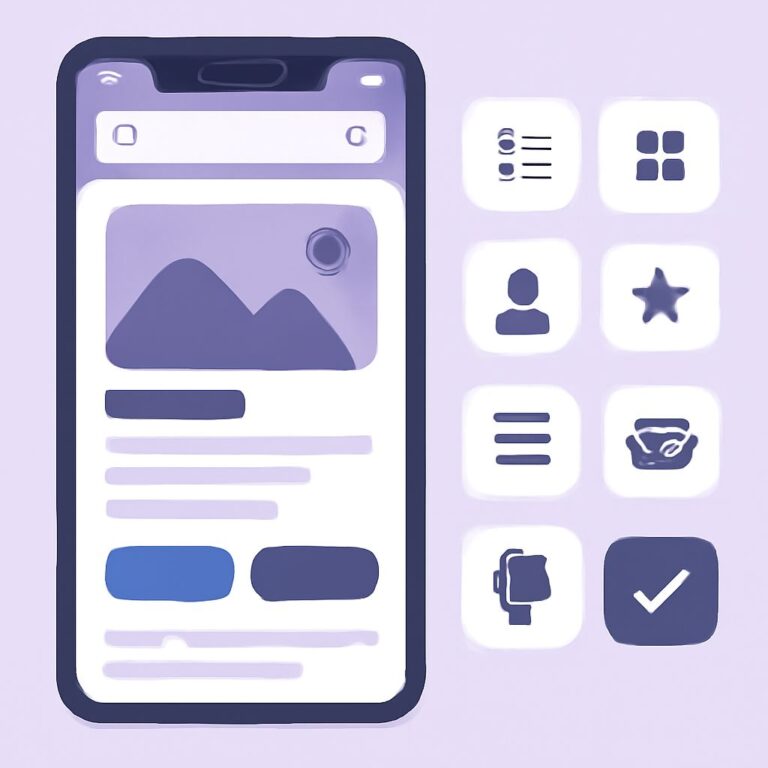Table of Contents
Introduction to Mobile UI Design
In today’s digital age, mobile applications have become a crucial part of everyday life. Their success largely depends on the User Interface (UI) design, which plays a critical role in enhancing user experience. For beginners venturing into mobile UI design, understanding the fundamental principles and practical tips is essential to creating user-friendly and aesthetically pleasing applications.
Understanding Mobile UI Design Principles
Before diving into the tips, it’s important to grasp some core principles of mobile UI design, which serve as the foundation for creating effective interfaces:
- Consistency: Consistent design elements help users recognize patterns and learn how to interact with the app faster.
- Clarity: Every element should have a clear purpose, and the design should focus on making the user’s journey as intuitive as possible.
- Feedback: Users should receive immediate feedback for their actions, whether by visual, auditory, or haptic responses.
- Affordance: Design elements should suggest their functionality. For example, buttons should look pressable.
- Accessibility: A design that caters to users with varying abilities ensures inclusivity and expands the app’s reach.
Essential Tips for Beginner Mobile UI Designers
As a beginner, mastering mobile UI design involves learning from best practices, experimenting, and continually refining your skills. Here are some essential tips to guide you:
1. Focus on Simplicity
One of the cardinal rules of mobile UI design is to keep it simple. Overloading users with information or too many functionalities can lead to confusion and frustration. Prioritize essential features and use visual hierarchy to guide the user’s attention to the most important elements.
2. Design for the Thumb
The majority of mobile users operate their devices with one hand, using their thumbs. Design your UI to ensure all important actions can be easily reached without straining the thumb. This approach, known as “thumb-friendly” design, is crucial for enhancing usability.
3. Utilize Grids and Layouts
Grids and layouts form the backbone of your design. They ensure that your UI elements are aligned properly, providing a clean and organized look. Using a consistent grid system helps maintain proportionality and balance across different screens and devices.
4. Prioritize Navigation
Navigation is key to any mobile app’s success. Opt for clear, intuitive navigation paths that make it easy for users to find what they are looking for. Common navigation patterns include tab bars, side drawers, and bottom navigation bars, each suited to different types of content.
5. Use Typography Wisely
Typography plays a vital role in readability and aesthetics of your app. Choose typefaces that are easy to read on small screens and maintain consistency in font sizes and styles. Use different weights and sizes to create a visual hierarchy, guiding users through your content seamlessly.
6. Optimize for Performance
Slow loading times and lag can deter users from using your app. Optimize your design by using appropriately compressed images, reducing the number of UI elements per screen, and choosing efficient code practices to ensure smooth performance.
7. Enhance with Microinteractions
Microinteractions are small, subtle animations or responses that enhance user engagement. They can be used to provide feedback, guide tasks, or add an element of delight. However, they should be used sparingly to avoid overwhelming the user.
8. Continuous User Testing
User testing is an ongoing process that can greatly improve your design. Gather feedback through beta tests, surveys, or user interviews to understand what works and what doesn’t. Iterate on your designs based on this feedback to improve user satisfaction.
Learning from Successful Mobile UI Designs
Another effective way to master mobile UI design is by studying successful apps. Analyze popular apps in your niche to understand what makes their design effective. Look for elements such as color schemes, typography, layout structure, and interactive elements. Learning from the pros can give you a better understanding of market standards and user expectations.
Conclusion
Mastering mobile UI design is a journey of continuous learning and experimentation. For beginners, focusing on core design principles and practical tips can lay a strong foundation for creating intuitive and aesthetically pleasing mobile interfaces. As you gain more experience, remember to keep the user at the center of your design process, continually refine your skills, and don’t be afraid to innovate. With dedication and creativity, you can create mobile apps that not only look good but also provide a seamless user experience.
Resources for Further Learning
| Resource | Type | Description |
|---|---|---|
| “Don’t Make Me Think” by Steve Krug | Book | A practical guide to understanding user experience and usability design. |
| Coursera: UI / UX Design Specialization | Online Course | A comprehensive series of courses on UI and UX design principles. |
| Smashing Magazine | Website | An online resource with articles and insights on the latest in design. |
FAQ
What are the key principles of mobile UI design?
The key principles of mobile UI design include simplicity, consistency, feedback, clarity, and user-centric design. These principles ensure an intuitive and effective user experience.
How can I ensure my mobile UI design is user-friendly?
To ensure a user-friendly design, prioritize intuitive navigation, maintain consistency across screens, use familiar icons and gestures, and conduct usability testing to gather feedback from real users.
What tools are recommended for beginners in mobile UI design?
For beginners, recommended tools include Sketch, Figma, Adobe XD, and InVision. These tools offer user-friendly interfaces and various resources to help you create effective mobile designs.
How important is responsive design in mobile UI?
Responsive design is crucial in mobile UI as it ensures your app or website functions well on various screen sizes and orientations. This enhances the user experience and accessibility across different devices.
What role does color play in mobile UI design?
Color plays a significant role in mobile UI design by influencing mood, guiding user actions, and improving readability. It is important to use a consistent color scheme that aligns with your brand and enhances usability.
How can I optimize mobile UI design for better performance?
Optimize mobile UI design by minimizing load times, using scalable vector graphics, reducing the number of elements per screen, and implementing efficient coding practices to ensure a smooth user experience.





